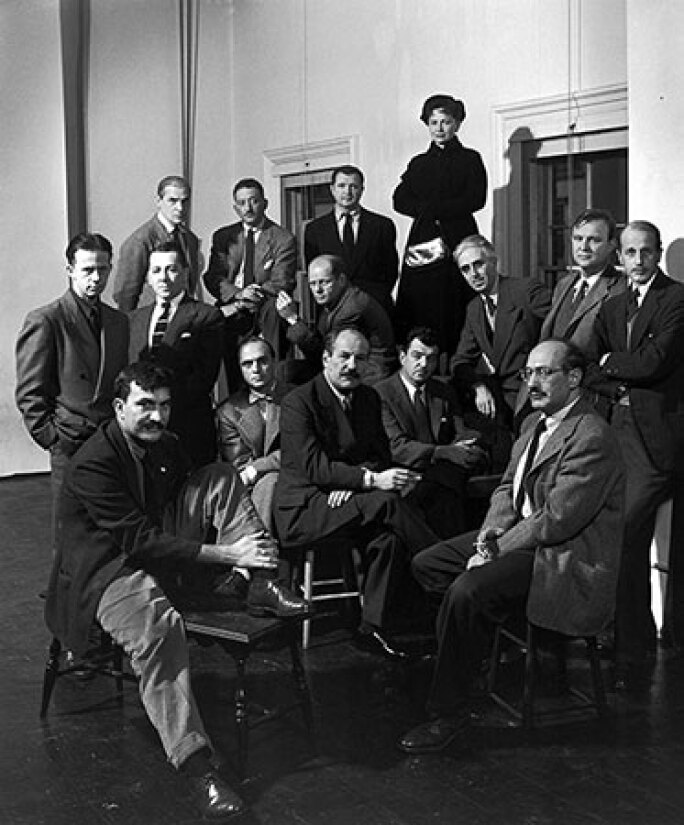Abstract Expressionism was centered in New York City in the late 1940s, but the radical new art movement would influence artists from Paris to Tokyo for decades to come. By abandoning representation in favor of pure color and form, the loosely affiliated group of artists including Jackson Pollock, Willem de Kooning, Franz Kline, Mark Rothko and Arshile Gorky established what would become the first US style to make international ripples. Their large-scale canvases and heroic gestures telegraphed a uniquely American brand of post-war ambition and confidence unlike anything seen before. Below are seven must-know facts about Ab-Ex and its key actors.

PORTRAIT OF A GROUP OF AMERICAN ABSTRACT ARTISTS, COLLECTIVELY KNOW AS 'THE IRASCIBLES,
'NEW YORK, NEW YORK, NOVEMBER 24, 1950. PHOTOGRAPH COURTESY NINA LEEN / CONTRIBUTOR / GETTY IMAGES.
1. Media Sensations: Like Impressionism before it, Ab-Ex received its designation from an art critic, In 1946, a New Yorker writer used the term to describe the paintings of Hans Hoffman. And in 1950, after signing an open letter to the Metropolitan Museum of Art protesting the exclusion of “advanced art” from a painting show, eighteen artists were photographed and dubbed “The Irascibles” in the pages of Life magazine (above).

WILLEM DE KOONING IN HIS STUDIO CIRCA 1940. PHOTOGRAPH COURTESY BOWDEN / BRIDGEMAN IMAGES.
2. Stowaways & Immigrants: Many of the practitioners of what critic Clement Greenberg called “American Type Painting” were immigrants. De Kooning arrived from the Netherlands as a stowaway on freighter bound for Argentina while Josef Albers, Gorky, Rothko and Hofmann all came to the US fleeing unrest in Europe.

HANS HOFMANN TEACHING in 1945. PHOTOGRAPH COURTESY MAURICE BEREZOV, © A. E. ARTWORKS.
3. Teacher, Teacher: A transplant to New York by way of Munich, painter Hans Hofmann established an art school on East 8th Street in Manhattan as well as a summer colony in Provincetown that became an unofficial kunstakademie where a generation of American artists was introduced to Picasso, Matisse and the European avant-garde.

JOAN MITCHELL, HELEN FRANKENTHALER, AND GRACE HARTIGAN AT THE OPENING OF FRANKENTHALER'S SOLO EXHIBITION
AT THE TIBOR DE NAGY GALLERY, NEW YORK, 12 FEBRUARY 1957. PHOTOGRAPH COURTESY BURT GLINN/MAGNUM PHOTOS.
4. Strong Women: Ab-Ex was a boy’s club, but in an unenlightened time, women made their mark: Grace Hartigan, Joan Mitchell, Alma Thomas, Perle Fine, Mary Abbott, and the fiercely ambitious Elaine de Kooning. Krasner had a long career after the death of Pollock, who, it must be noted, had crucial support from two other women: Peggy Guggenheim, an early collector, and dealer Betty Parsons first showed his drip paintings in her gallery in 1948.

LEE KRASNER, COMBAT, 1965. COLLECTION OF NATIONAL GALLERY OF VICTORIA, MELBOURNE.
PHOTOGRAPH COURTESY © THE ESTATE OF LEE KRASNER / ARTISTS RIGHTS SOCIETY (ARS), NEW YORK / ADAGP, PARIS 2018.
5. Neighbors: Many Ab-Ex artists resided within a few blocks of each other in Greenwich Village, dropping in on each other unannounced (nobody had a phone). De Kooning kept a studio on 10th Street and Franz Kline was on 9th Street – a block from Krasner and Pollock, who shared a cold-water flat on 8th before decamping to eastern Long Island.

JACKSON POLLOCK IN HIS STUDIO ON THE EAST END OF LONG ISLAND.
PHOTO BY MARTHA HOLMES/THE LIFE PICTURE COLLECTION/GETTY IMAGES
6. Loners: The artists knew each other, but unlike the European Surrealists whose work they admired, they did not think of themselves as a movement with a manifesto. As critic and Ab-Ex champion Dore Ashton recently noted, the “group” that we refer to now were “a whole bunch of raving individuals.”

GRACE HARTIGAN LAUGHS WITH FRIENDS IN THE CEDAR TAVERN, 1959.
PHOTOGRAPH COURTESY JOHN COHEN / CONTRIBUTOR / GETTY IMAGES.
7. Late-Night Haunts: The Cedar Tavern and Dillon’s were favored hangouts for socializing, discussing art and – not unusually for this hard-drinking crowd – arguments. At Dillon’s in 1960, de Kooning punched Clement Greenberg after the critic took a jab at his recent work, and Pollock was banned from the Cedar for pulling the bathroom door off its hinges during an argument with Franz Kline.
Discover abstract artworks in our upcoming auctions Contemporary Art Evening Sale (31 March, Hong Kong) and Raising The Bar: Masterworks from the Collection of Morton and Barbara Mandel (16 May, New York).







